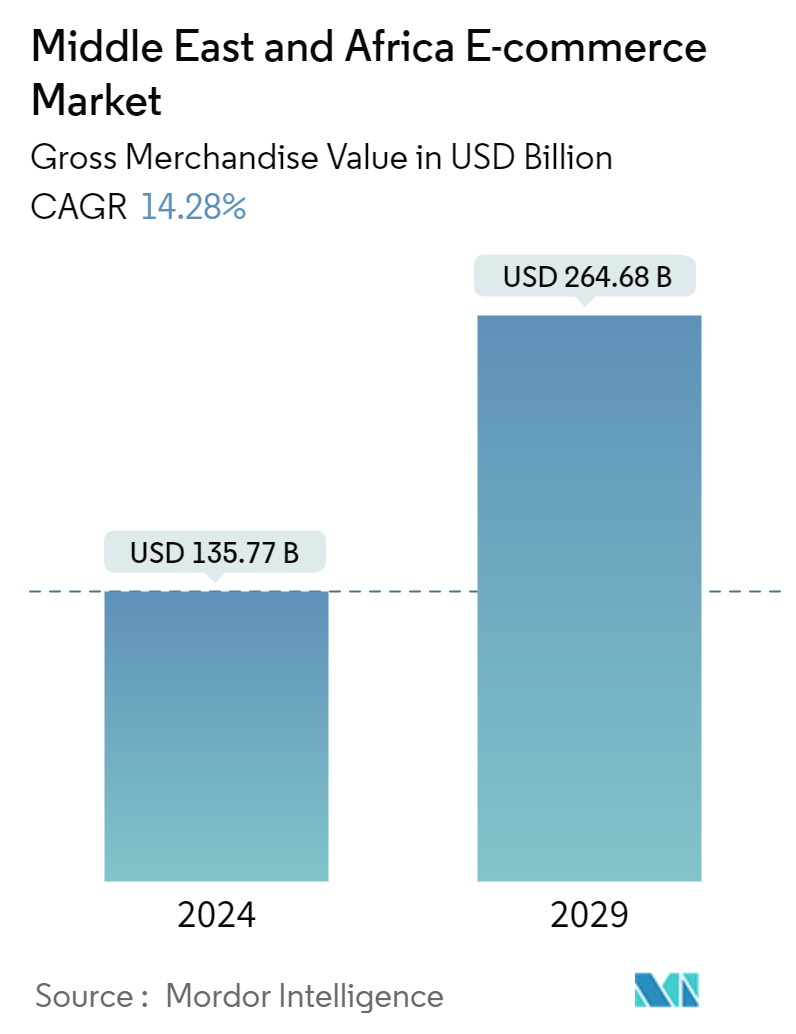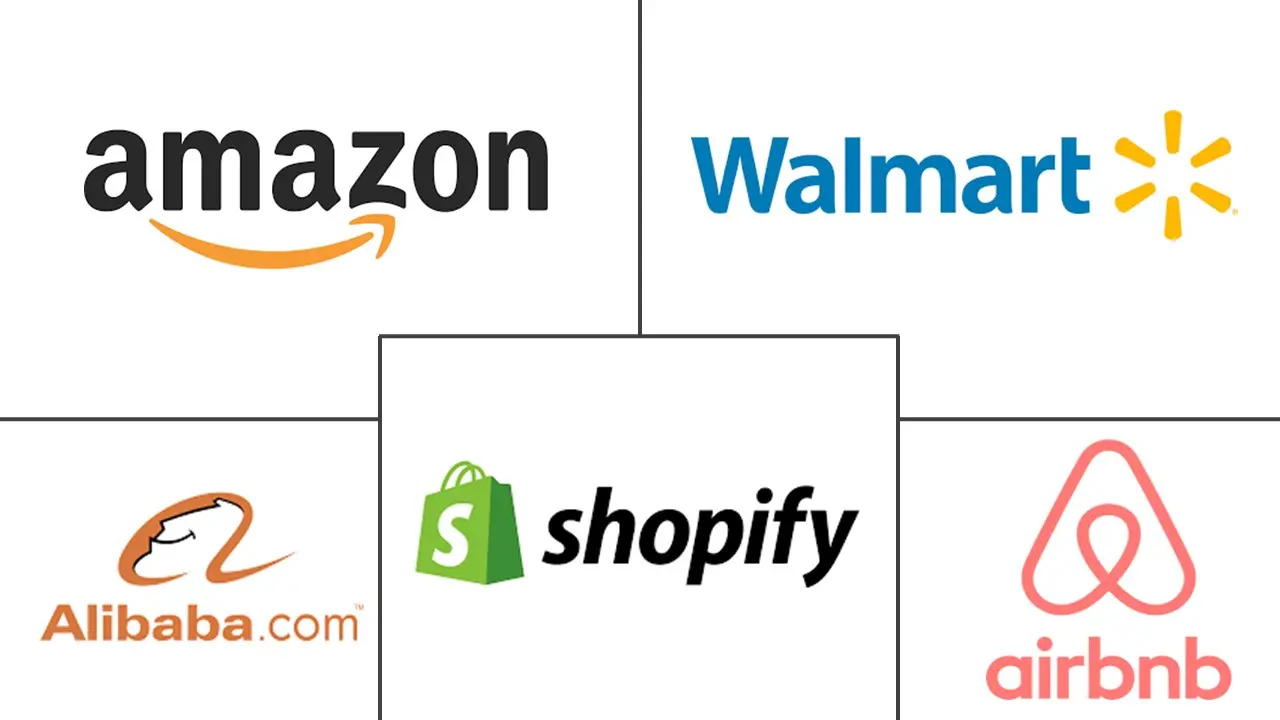Market Size of Middle East And Africa E-commerce Industry

| Study Period | 2019 - 2029 |
| Base Year For Estimation | 2023 |
| Market Size (2024) | USD 135.77 Billion |
| Market Size (2029) | USD 264.68 Billion |
| CAGR (2024 - 2029) | 14.28 % |
| Market Concentration | Medium |
Major Players
*Disclaimer: Major Players sorted in no particular order |
Middle East And Africa E-commerce Market Analysis
The Middle East And Africa E-commerce Market size in terms of gross merchandise value is expected to grow from USD 135.77 billion in 2024 to USD 264.68 billion by 2029, at a CAGR of 14.28% during the forecast period (2024-2029).
- High internet penetration, urbanization, and a surge in mobile shopping are key drivers propelling the e-commerce market in this region. The adoption of e-commerce automation offers substantial growth avenues for market players.
- With one of the world’s youngest populations, the Middle East is witnessing a rapid rise in smartphone usage. Consequently, numerous e-commerce platforms have pivoted to mobile apps to enhance and sustain user interaction.
- The growing integration of e-commerce platforms with AI, predictive analytics, and cloud computing boosts market growth. In addition, the number of foreign enterprises in the region is increasing.
- In the Middle East's e-commerce landscape, personalization and customer experience are pivotal. Retailers are leveraging data analytics and customer segmentation to offer tailored shopping experiences, personalized product suggestions, and targeted promotions. By prioritizing personalization, the goal is to enhance satisfaction, foster loyalty, and boost repeat purchases.
- Owing to the COVID-19 pandemic and the adoption of social distancing, a significant segment of the regional population shifted from traditional brick-and-mortar stores to online platforms. These retailers are at the forefront, offering a seamless shopping experience.
- Traditional brick-and-mortar outlets contend fiercely with their online counterparts, prompting a notable shift in how consumers shop. To stay relevant, retailers are swiftly bolstering their digital footprints, embracing omnichannel strategies, and harnessing technology to elevate the overall customer experience.
Middle East And Africa E-commerce Industry Segmentation
E-commerce refers to the digital sale of goods and services, spanning various models, including B2C (business-to-consumer) and B2B (business-to-business). These platforms bring benefits like lower inventory costs, increased profits, varied discounts, and streamlined delivery services.
The e-commerce market in Middle East and Africa is segmented by B2C e-commerce (beauty and personal care, consumer electronics, fashion and apparel, food and beverage, furniture and home, and others), B2B e-commerce, and country (the United Arab Emirates, Saudi Arabia, South Africa, and Rest of Middle East and Africa). The market sizes and forecasts are provided in terms of value (USD) for all the above segments.
| By B2C ecommerce | ||||||||
| Market size (GMV) for the period of 2019-2029 | ||||||||
|
| By B2B ecommerce | |
| Market size for the period of 2019-2029 |
| Geography | |
| United Arab Emirates | |
| Saudi Arabia | |
| South Africa | |
| Rest of Middle-East and Africa |
Middle East And Africa E-commerce Market Size Summary
The Middle East and Africa e-commerce market is poised for significant expansion, driven by factors such as high internet penetration, increasing urbanization, and the rise of mobile shopping. The region's youthful population and growing smartphone usage have led many e-commerce platforms to transition to mobile applications, enhancing user engagement. The integration of advanced technologies like AI, predictive analytics, and cloud computing further propels market growth. Despite the promising outlook, online shopping has not yet fully integrated into the consumer habits of the region, with many still preferring traditional retail experiences. However, the shift towards digital channels has been accelerated by the COVID-19 pandemic, which encouraged a move from physical stores to online shopping, supported by the growing preference for digital payment methods.
The e-commerce landscape in the Middle East and Africa is characterized by intense competition, with both local and international players vying for market share. Companies such as Amazon, Alibaba, and Shopify are actively expanding their presence, employing strategies like product launches, research and development, and strategic partnerships to maintain their competitive edge. The B2B sector is expected to experience rapid growth, outpacing the B2C sector, driven by the proliferation of digital payments. In Africa, SMEs are increasingly establishing their digital identities to enhance e-commerce capabilities and export potential. The region is also witnessing innovations in mobile commerce, fueled by high connectivity, smartphone adoption, and the introduction of low-cost devices. These developments, coupled with investments in commercial 5G networks, are set to transform the e-commerce landscape, offering new opportunities for growth and expansion.
Middle East And Africa E-commerce Market Size - Table of Contents
-
1. MARKET INSIGHTS
-
1.1 Market Overview
-
1.2 Industry Attractiveness- Porter's Five Forces Analysis
-
1.2.1 Bargaining Power of Suppliers
-
1.2.2 Bargaining Power of Buyers/Consumers
-
1.2.3 Threat of New Entrants
-
1.2.4 Threat of Substitute Products
-
1.2.5 Intensity of Competitive Rivalry
-
-
1.3 Key market trends and share of e-commerce of total Retail sector
-
1.4 Impact of COVID-19 on the e-commerce sales
-
-
2. Market Segmentation
-
2.1 By B2C ecommerce
-
2.1.1 Market size (GMV) for the period of 2019-2029
-
2.1.2 Market Segmentation - by Application
-
2.1.2.1 Beauty & Personal Care
-
2.1.2.2 Consumer Electronics
-
2.1.2.3 Fashion & Apparel
-
2.1.2.4 Food & Beverage
-
2.1.2.5 Furniture & Home
-
2.1.2.6 Others (Toys, DIY, Media, etc.)
-
-
-
2.2 By B2B ecommerce
-
2.2.1 Market size for the period of 2019-2029
-
-
2.3 Geography
-
2.3.1 United Arab Emirates
-
2.3.2 Saudi Arabia
-
2.3.3 South Africa
-
2.3.4 Rest of Middle-East and Africa
-
-
Middle East And Africa E-commerce Market Size FAQs
How big is the Middle East And Africa E-commerce Market?
The Middle East And Africa E-commerce Market size is expected to reach USD 135.77 billion in 2024 and grow at a CAGR of 14.28% to reach USD 264.68 billion by 2029.
What is the current Middle East And Africa E-commerce Market size?
In 2024, the Middle East And Africa E-commerce Market size is expected to reach USD 135.77 billion.

